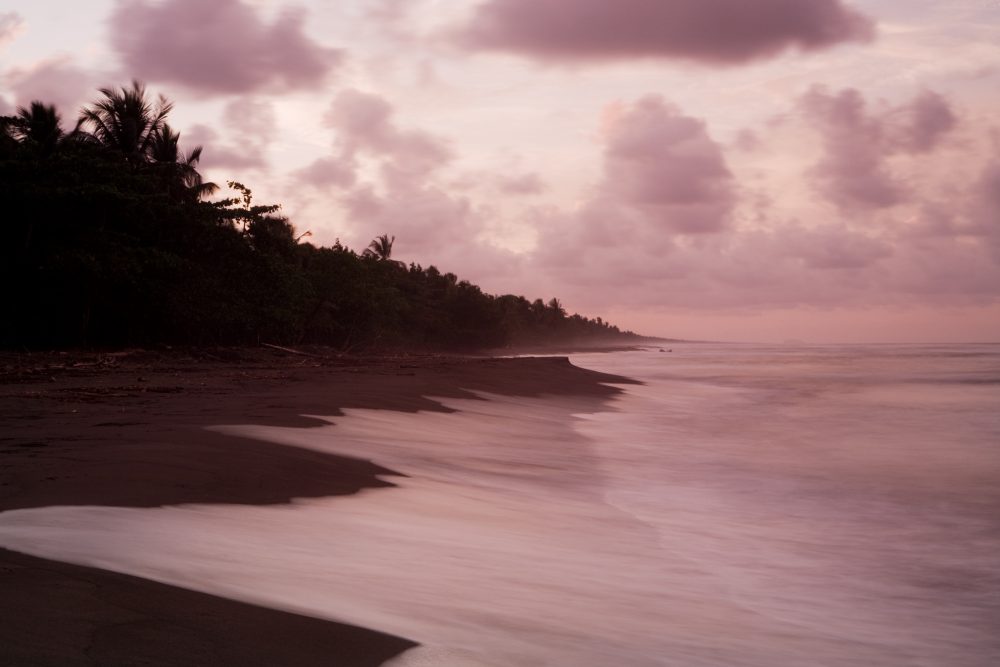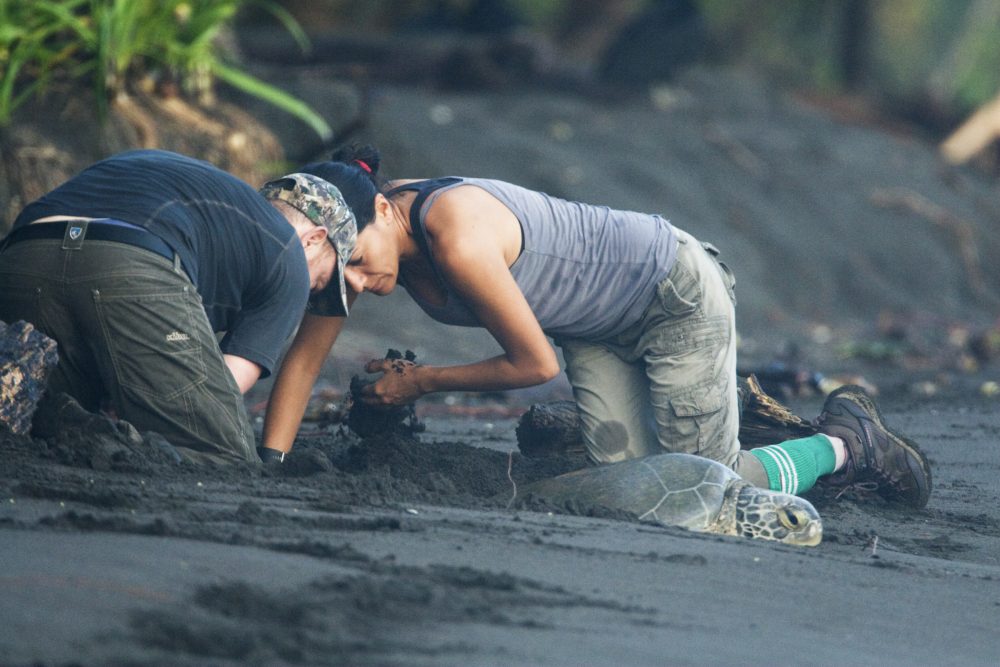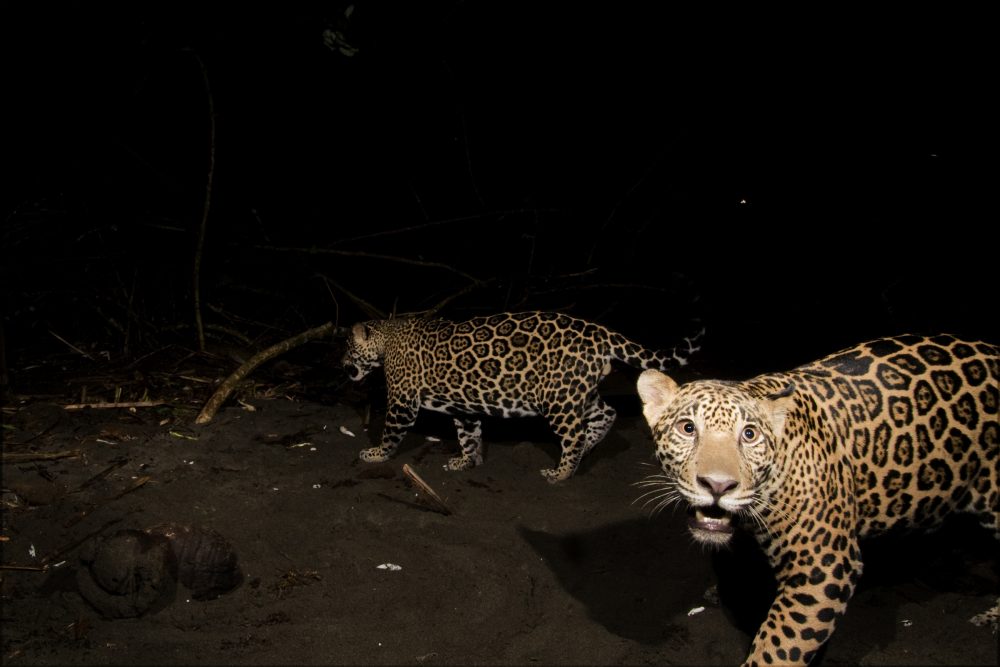Photographs by Sebastian Kennerknecht
Written by Betsy Painter
Along the borders of Tortuguero beach in Costa Rica, sturdy tree trunks guard the entrance to the rainforest like a gate, and palm fronds bend down from the canopy and sweep across the ground, drawing a line in the sand. In the categorized recesses of our minds, as far as biomes are concerned, we tend to keep rainforest and ocean life separate. Jellyfish and chameleons may share eccentric colors, but have no ecological business between them. Three-toed sloths and shrimp may both be underdogs in speed and size respectively, but would never compete in the race for resources. But on the shore of Tortuguero National Park, the nautical-jungle boundary is constantly crossed by an unusual pair: jaguars (Panthera onca) and sea turtles.
On any ordinary evening on Tortuguero beach, through the lens of a carefully placed camera trap, this interesting interaction begins as the phantom predator of the rainforest, one of the toughest to track, steps out through the forest bush and onto the beach. Like shadows on the shore, jaguars stalk across the sand in search of sea turtles. While cultural legends and myths attribute supernatural characteristics to jaguars, building off of their cryptic nature, the jaguars are not there to haunt, but to hunt.
Jaguars are “opportunistic predators” with diets depending on the availability of prey. On Tortuguero beach, sea turtles arrive each nesting season in impressive numbers to lay their eggs. It is the largest rookery in the western hemisphere for the endangered green turtle (Chelonia mydas), and also serves as a nesting ground for three other sea turtle species: leatherback (Dermochelys coriacea), hawksbill (Eretmochelys imbricate) and loggerhead (Caretta caretta). As the sea turtles roll in with the waves, the natural instincts of the jaguars draw them out from their hidden lives in the rainforest and towards the tide.
Paw prints in the sand
In the rainforest, jaguars’ tawny golden coats marked with smudged dark spots camouflage with the earthy scenery of tangled vines, rugged bark and dense vegetation. However, on their nightly prowls on the beach, the only veil is the dim light of the evening sky, and their large paw prints left behind in the sand serve as clues to their activities. Following the path of the prints leads to abandoned sea turtle carcasses that vultures and other scavengers now claim for their clean-up role in nature. Provision for scavenger species is one way predator-prey relationships prove vital to ecosystems.
These tracks also prove helpful for scientists Ian Thomson and Stephanny Arroyo-Arce on their research investigating this predator-prey relationship through their ongoing Coastal Jaguar Conservation project with the collaboration of Global Vision International (GVI). Little was known about the impact jaguars have on sea turtle populations on the Caribbean coast of Costa Rica before the work of Thomson and Arroyo-Arce. Through weekly surveys along a 14 1/2-mile stretch of the coast from 2005 to the present, researchers have collected data by counting identifiable jaguar tracks and marine turtle carcasses containing evidence of jaguar predation. Their research found that within 18 miles of coastline, jaguar predation accounts for less than three percent of the nesting green turtle population on the beach. Based on the researchers’ current findings these jaguar predation rates are not considered a significant threat to the green sea turtle populations. For the other marine turtle species, it is too difficult to measure the effects of jaguar predation based on available evidence because cases only occur sporadically. However, for all marine turtles, the impact of jaguar predation on the populations is minimal compared to the losses caused by human activities such as illegal poaching, commercial exploitation and incidental captures in fishing gear.
Human pressures push jaguars to the coast
Anthropogenic pressures may also be influencing the jaguars’ shift towards coastal habitats. One human factor comes into play in the form of habitat degradation in the buffer zones around the park. In the early 1990’s, an expansion of large-scale banana and pineapple plantations outside of the park coincided with an increase in jaguar predation of marine turtles.
Another factor may be illegal hunting of other prey species inside the park. Jaguars have over 85 prey species throughout their ranges, and within Tortuguero National Park specifically, common prey includes the white-lipped peccary (Tayassu pecari), the green iguana (Iguana iguana), and both species of sloth found in the area, the three-toed (Bradypus variegatus) and the two-toed (Choloepus hoffmanni). Illegal hunting of these species can decrease the populations and potentially encourage jaguars towards more readily available prey like the sea turtles.
A not so antisocial big cat
This abundance of marine prey has also led researchers to believe that they are documenting a reduction in competition between the jaguars. Thomson and Arroyo-Arce have recorded over 36 jaguars on a meager 18-mile strip of coastline since 2010. Anywhere else jaguars are described as being typically solitary with vast territories and sparse overlap. With jaguars in closer proximity to each other on Tortuguero beach, the scientists are observing rare and unusual social behaviors in the big cats, such as facultative scavenging and smaller territories with increased interactions between individuals. Some of these activities have never before been documented in the wild.
For example, as part of the long-term monitoring program by Thomson and Arroyo-Arce, one camera trap video lasting seven minutes captured two male jaguar cubs nursing from their mother at an atypically advanced age, giving new insight to maternal and cub behavior.
The role of conservation science
This opportunity to study jaguar behavior up close is remarkable, yet the link to sea turtle predation may be challenging for some. The poetic drama of natural predation, where one species experiences loss at the benefit of another, is heightened by the fact that conservationists champion both the declining jaguar populations and the endangered sea turtles. But nature is not sentimental, nor does it favor one species over another based on emotion. Rather it is detached from humanity in this way—wild, free, and sometimes hauntingly so. The role of scientists is not to judge the fairness of what takes place, but to study and observe. It’s a position of humility, as they stoop to the ground to observe a print, take notes on a fallen prey, or ask questions that reveal there is still much to learn. The objective freedom of science allows the facts to speak louder so that we can make truly informed decisions when it comes to managing wildlife populations and ecosystems.
The unusual jaguar and sea turtle relationship on Tortuguero Beach unites our marine and forest worlds, reminding us that nature is a vibrant, breathing, interwoven network. As the beach continues to boast a stable population of sea turtles, jaguar connectivity will grow and gene flow will increase between populations, strengthening them in Tortuguero and beyond. Humanity’s actions and choices are a force in between the strands of nature’s web, and the goal is to address where these actions may impair that balance. Thomson and Arroyo-Arce are working with the local communities, the local government and other conservation organizations to protect this unique place, which will be essential for the long-term survival of both jaguars and marine turtles.
Bibliography
Stephanny Arroyo-Arce and Roberto Salom-Pérez. 2015. Impact of jaguar Panthera onca (Carnivora: Ferlidae) predation on marine turtle populations in Tortuguero, Caribbean coast of Costa Rica. Rev. Biol. Trop. 63: 815-825.
Arroyo-Arce et al. 2014. Habitat features influencing jaguar Panthera onca (Carnivora: Felidae) occupancy in Tortuguero National Park, Costa Rica. Rev. Biol. Trop. 62: 1449-1458.
Arroyo-Arce et al. 2017. First record of jaguar (Panthera onca) predation on a loggerheard sea turtle (Caretta caretta) in Tortuguero National Park, Costa Rica. Herptology Notes 10:17-18.
Thomson et al. 2014. Record of two jaguar cubs suckling from their mother in the wild. Cat News 61:8.













